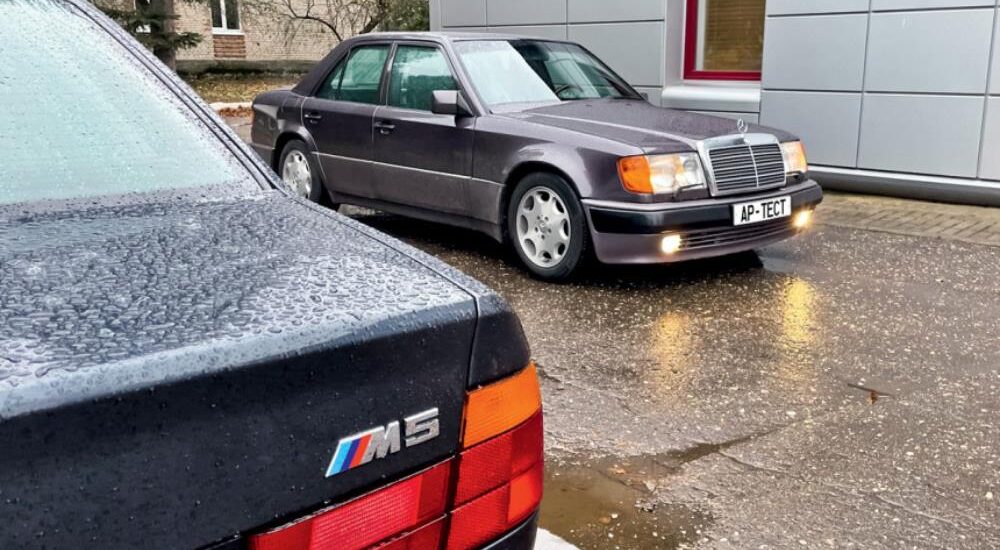Lorsque Mercedes a annoncé la W124, BMW a répliqué avec la E34. La réponse de Munich fut claire et nette avec la proclamation de la M5, et Stuttgart ne tarda pas à répondre avec la 500 E. Il est intéressant de noter que, malgré les différences marquées entre ces super berlines, elles partagent un point de départ particulier : toutes deux ont commencé leur voyage dans une carrosserie de camion.

Le projet W124 a débuté en 1977, avec le dessin initial réalisé par Peter Pfeiffer et Josef Gallitzendörfer, et a été finalisé par le chef du centre de style, Bruno Sacco.
Le ton de la rivalité a été indéniablement donné par BMW dans les années 1980, animé par l’ambition de dépasser Mercedes. La concurrence était si féroce que Munich a dû redoubler d’efforts pour rester dans la course. Il fallait une percée pour prendre l’avantage, ce qui fut fait avec le lancement de la E32 “Seven” en 1986, suivi de la BMW 750i à moteur V12 un an plus tard. Le défi consistait alors à reproduire ce succès avec la “Five”.
Lancées en 1988, les berlines E34 ont été conçues avec un seul objectif : surpasser la redoutable W124. Quatre ans après son lancement, la Mercedes reste une merveille d’ingénierie automobile. Lors de notre essai rétro, je me suis plongé dans le BMW Praxis, un catalogue de concessionnaire utilisé pour former les vendeurs à la nouvelle “Five”. Ce manuel de 240 pages est un trésor de détails sur la E34, rempli d’informations rarement trouvées ailleurs.
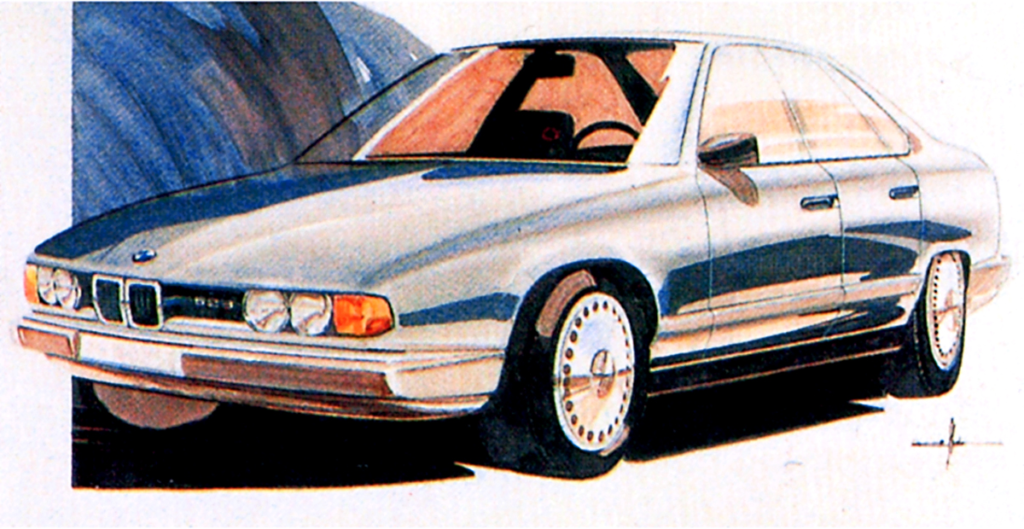
Les gènes italiens du E34 ont été dessinés en 1982 par Ercole Spada. Le travail sur le “Five” a été poursuivi par Jay Mays et achevé sous la direction de Klaus Luthe.
Des stratégies de marketing aux innovations techniques, la rivalité était intense. BMW a analysé les parts de marché de différentes professions, notant une préférence pour l'”hélice” chez les cadres moyens et pour l'”étoile” chez les cadres supérieurs et les indépendants. BMW a également vanté les mérites de l’aérodynamisme, annonçant une amélioration de 18 % par rapport à son prédécesseur et un coefficient de traînée de 0,30, tout en conservant le design emblématique de sa calandre. Subtilement, elle a laissé entendre que ses résultats auraient pu être encore meilleurs sans sa politique de pneus standard – un coup de gueule contre Mercedes, dont les meilleurs résultats aérodynamiques ont été obtenus avec des pneus plus étroits.

L’équilibre entre la fonctionnalité (axe vertical) et l’esthétique (axe horizontal) tel qu’il est perçu par BMW. Il s’avère que Lancia est la moins pratique, tandis qu’Audi est considérée comme la moins belle.
Des innovations telles que le système d’essuie-glace unique de Mercedes, qui permet de nettoyer 86 % du pare-brise, ont été remplacées par les essuie-glaces allongés de BMW, qui ont conservé la même zone de nettoyage, mais ont ajouté un mécanisme permettant d’améliorer la performance des balais à faible vitesse. De même, alors que Mercedes se vantait de chauffer automatiquement les rétroviseurs et les gicleurs, BMW a introduit un mécanisme de verrouillage chauffant activé en tenant la poignée de la porte – une caractéristique d’ingénierie réfléchie.

Il est évident que les entreprises ont travaillé différemment sur le front-end. Pour Mercedes, les optiques et la calandre agissent comme un outil aérodynamique qui contribue à réduire la portance. Pour BMW, les phares sont avant tout le visage de la marque. Néanmoins, le catalogue BMW Praxis fournit des chiffres intrigants : pour vaincre la résistance de l’air à une vitesse de 180 km/h, la E34 a besoin de 64 ch, et à 200 km/h, elle a besoin de 87 ch. C’est 20 % de moins que son prédécesseur, le E28, avec un nez de requin similaire.
Chaque modèle présentait des caractéristiques conçues pour surpasser l’autre. La célèbre suspension arrière à cinq bras de Mercedes s’est heurtée aux améliorations apportées par BMW à la configuration existante de la E34, notamment des amortisseurs à commande électronique et un système de direction Servotronic. BMW a également répondu à l’ASR de Mercedes avec son système avancé ASC+MSR, qui s’attaque non seulement à la traction, mais aussi au blocage des roues lors de la décélération.
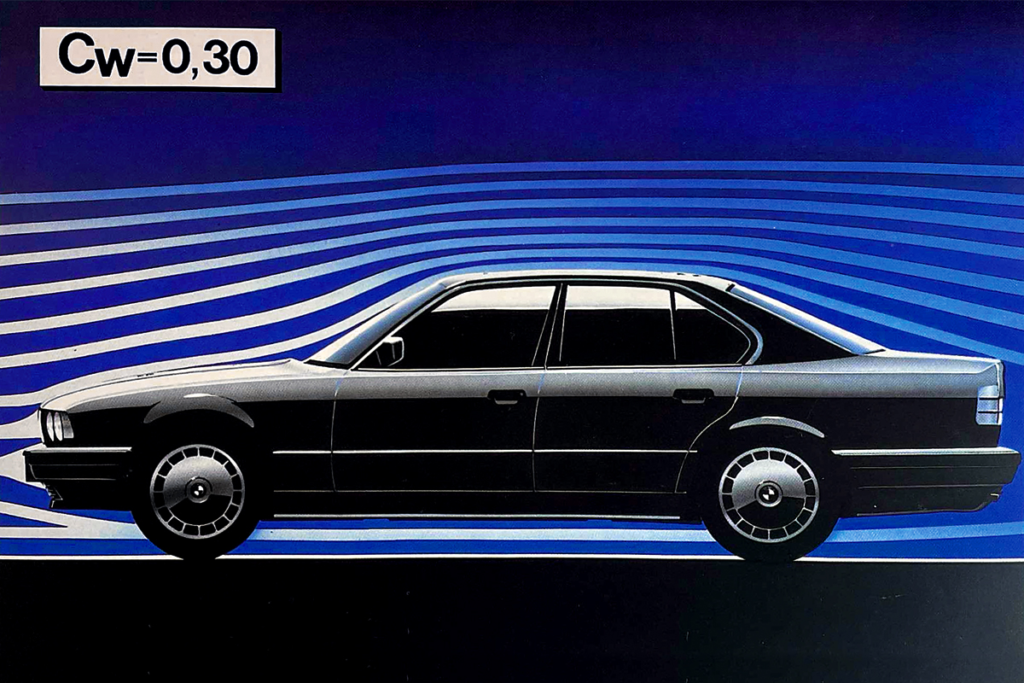
Le catalogue explique même les caractéristiques de tenue de route de la M5, suggérant que BMW a intentionnellement réglé le châssis pour un sous-virage neutre ou léger pouvant passer à un survirage avec l’accélérateur, sans doute pour contrer le caractère nerveux de la Mercedes.
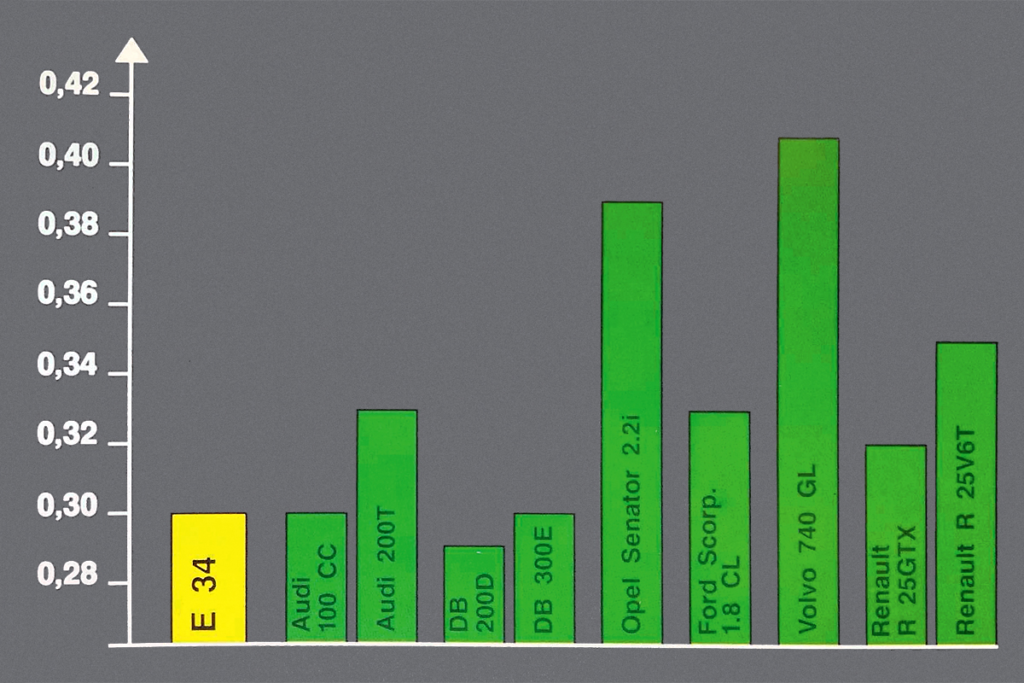
L’aérodynamisme des classiques et des contemporains. Pour rattraper Mercedes, BMW a fait appel à des employés d’Audi.
Cette bataille permanente de la surenchère n’a pas seulement repoussé les limites technologiques, elle a également mis en évidence une rivalité profondément ancrée. Si la E34 a momentanément devancé la W124, elle n’a pas pu reproduire l’impact révolutionnaire de la E32 à moteur V12. Bien qu’elle partage la même plate-forme que la “Seven”, la “Five” a toujours semblé avoir un train de retard sur son homologue de Stuttgart, chassant les innovations telles que la transmission intégrale et les améliorations en matière de sécurité dont Mercedes était la pionnière.
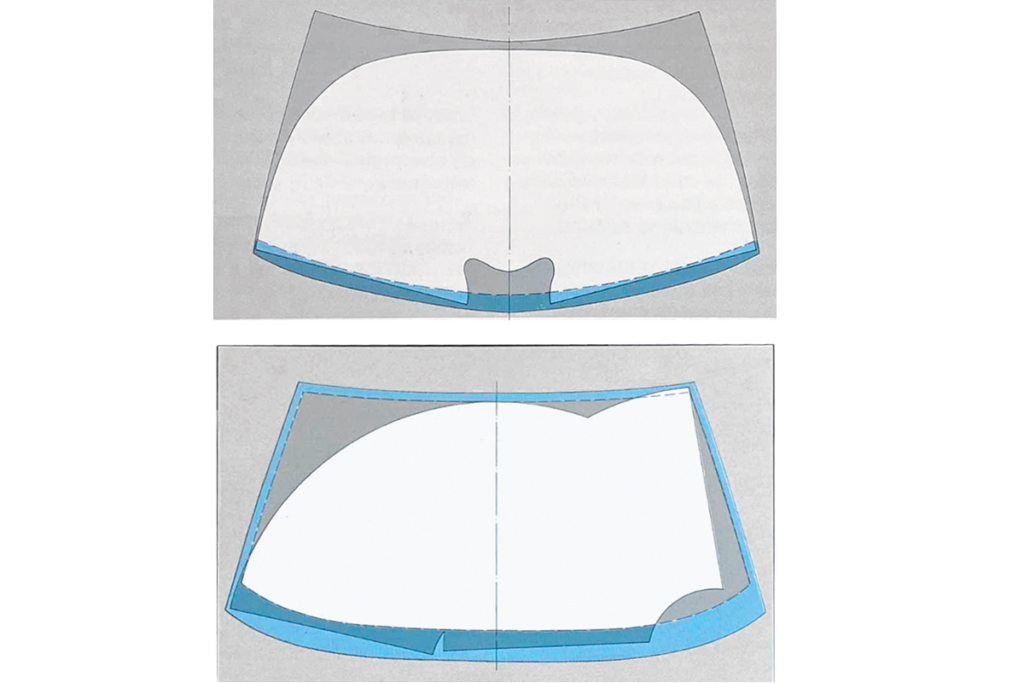
L’essuie-glace Mercedes atteint les coins supérieurs et offre une surface de nettoyage du pare-brise record pour l’industrie automobile. BMW insiste sur le fait que le coin supérieur gauche est plus important pour la visibilité aux feux de circulation.
La BMW M5 reste un témoignage de cette compétition féroce, incarnant la poursuite incessante de l’excellence et de l’innovation dans le domaine de l’automobile. En se poussant mutuellement vers les sommets, ces rivaux ont laissé un héritage de prouesses techniques et de performances qui continue d’inspirer le monde de l’automobile.
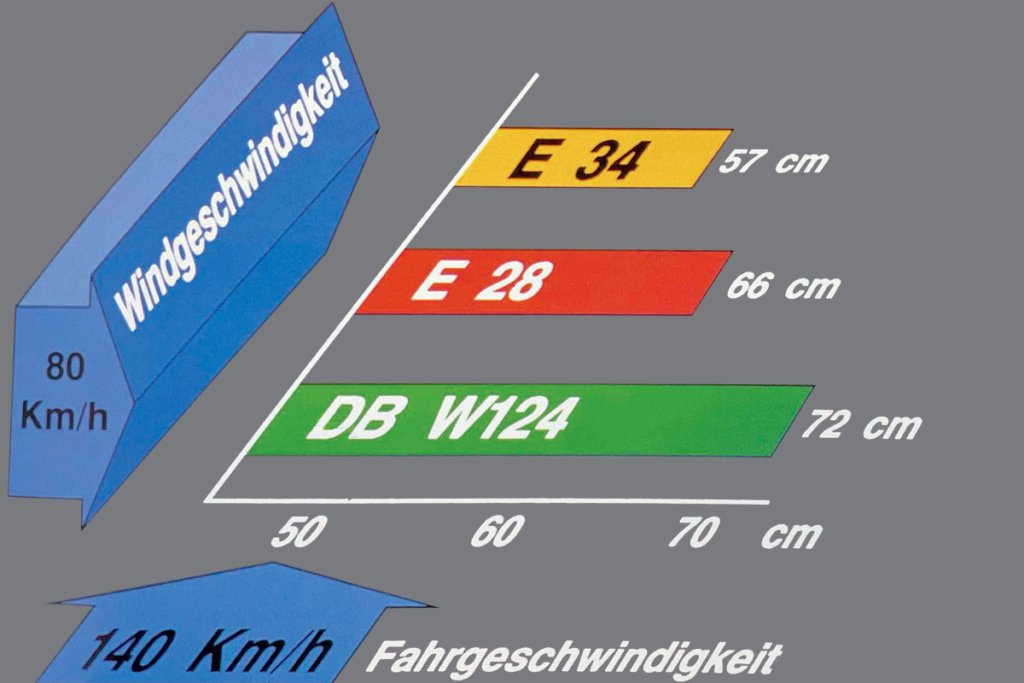
Autre raison de souligner la supériorité sur Mercedes : en cas de vent latéral, la E34 dérive moins que la W124.
Lorsque Mercedes a lancé la W124, BMW n’a pas tardé à répondre avec la E34, annonçant son propre chef-d’œuvre, la M5. La réplique de Stuttgart, la 500 E, marque le début d’une rivalité fascinante entre deux super berlines très différentes, partageant toutes deux une origine surprenante : chaque modèle a commencé sa vie sur un châssis de camion.
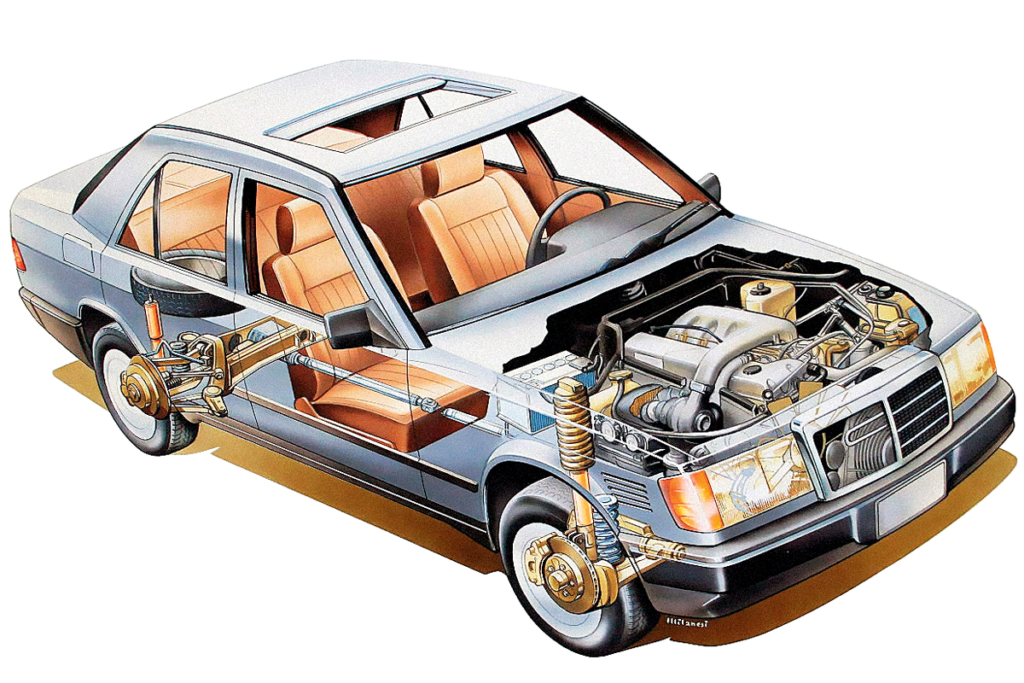
Le principal atout technique du châssis de la W124 est la suspension arrière multibras, apparue un peu plus tôt sur les petites berlines W201 et installée par la suite sur la quasi-totalité des voitures de tourisme Mercedes. Il a été copié par de nombreux autres fabricants. Avec des modifications, ce schéma de base à cinq maillons est encore utilisé aujourd’hui.
Dans les années 1980, BMW s’efforce de surpasser Mercedes. Stuttgart est redoutable et oblige Munich à redoubler d’efforts pour ne pas se laisser distancer. Pour surpasser Mercedes, BMW avait besoin de quelque chose d’extraordinaire. Elle y est parvenue en 1986 avec le lancement de la E32 “Seven” et a encore étonné le monde de l’automobile un an plus tard avec la BMW 750i équipée d’un moteur V12. Le défi consistait à reproduire ce succès avec la “Five”.
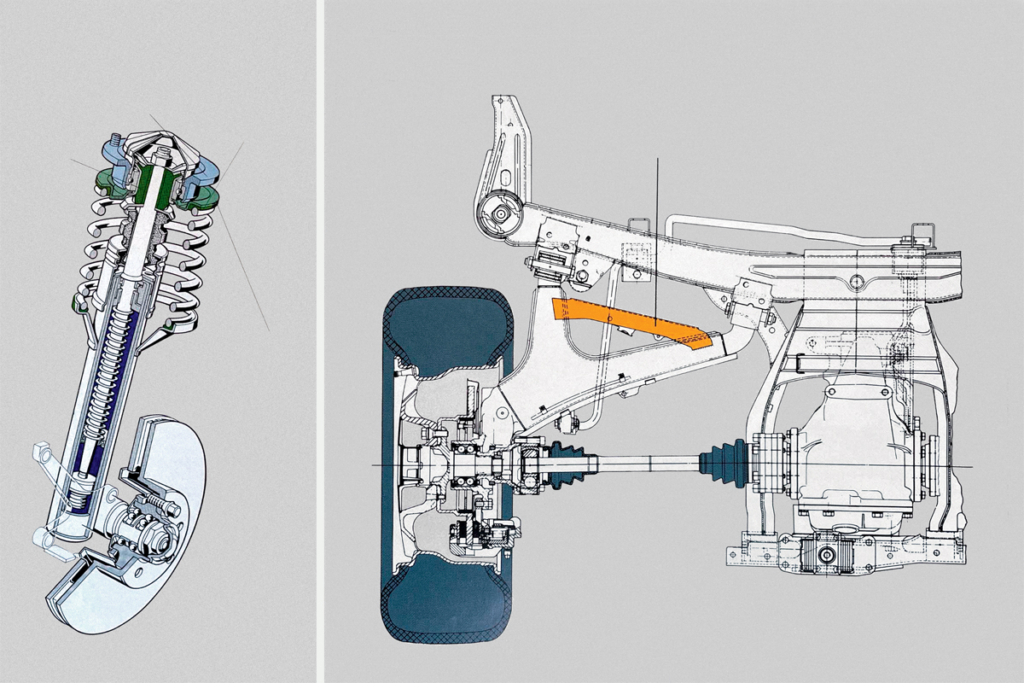
Pour toutes les versions E34 supérieures aux BMW 525i et 524td, des jambes de force McPherson avec des supports de ressorts et d’amortisseurs séparés ont été fournies. À l’arrière, les bras obliques sont renforcés par des renforts. Ce fut la dernière “Five” dotée d’un essieu arrière aussi ancien. En option, à l’exception de la M5, une suspension Sport plus rigide était proposée.
Lancées en 1988, les berlines E34 avaient une cible en ligne de mire : l’exceptionnelle W124. Quatre ans après ses débuts, la Mercedes incarnait toujours le zénith de l’ingénierie automobile.
Lors de nos essais rétrospectifs, j’ai passé plusieurs jours avec un catalogue de concessionnaire unique, le BMW Praxis, conçu pour former le personnel de vente à la nouvelle “Cinq”. Cette bible de 240 pages sur la E34 couvre chaque détail et chaque décision de conception du véhicule. Il regorge d’informations uniques et coûte 30 000 roubles, ce qui témoigne de sa valeur. Notamment, la W124 est mentionnée sur presque toutes les pages, ce qui souligne une apparente obsession.
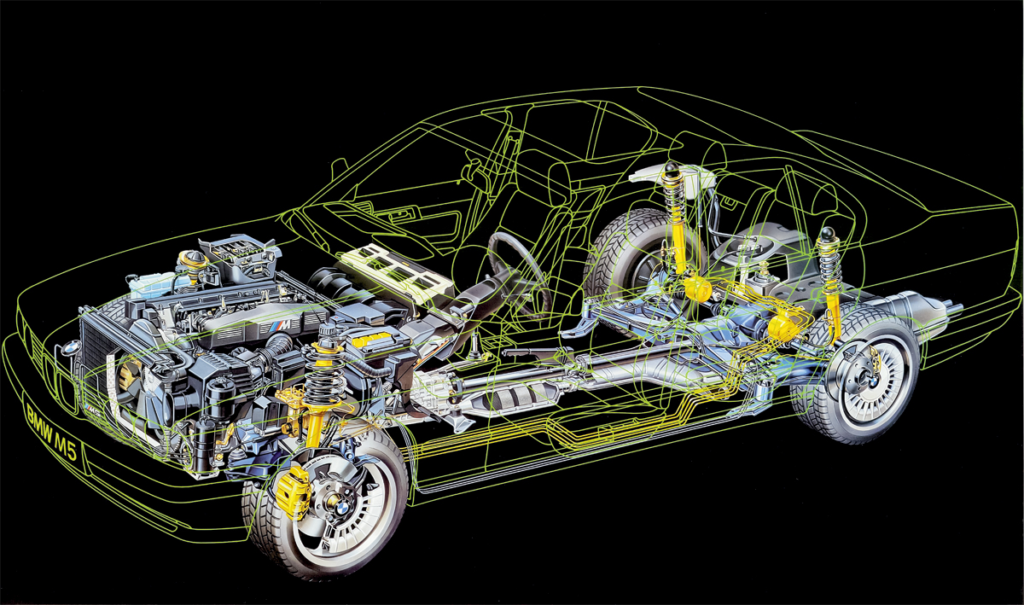
La suspension multibras complexe comparable de BMW n’est apparue qu’en 1989 sur le coupé E31, puis sur la “Seven” E38 et la “Five” E39. Mais la M5 E34, avant même la sortie de la Mercedes 500 E, était équipée de série d’amortisseurs arrière dotés d’un mécanisme hydraulique d’autonivelage permettant de maintenir les angles de carrossage des roues et la garde au sol à un niveau constant.
La bataille a commencé par les stratégies de marketing, BMW se livrant à des comparaisons détaillées des parts de marché dans les différentes professions. La marque “Propeller” a trouvé plus d’écho auprès des cadres moyens, tandis que la marque “Star” a été plébiscitée par les cadres supérieurs et les indépendants. BMW s’est également vanté de ses prouesses en matière d’ingénierie, revendiquant une amélioration aérodynamique significative par rapport à son prédécesseur et atteignant un coefficient de traînée de 0,30, tout en conservant l’inclinaison négative emblématique de ses narines. Elle a subtilement suggéré que ces résultats auraient pu être encore meilleurs, laissant entendre que des concurrents comme Mercedes utilisaient des pneus plus étroits pour atteindre des chiffres optimaux.
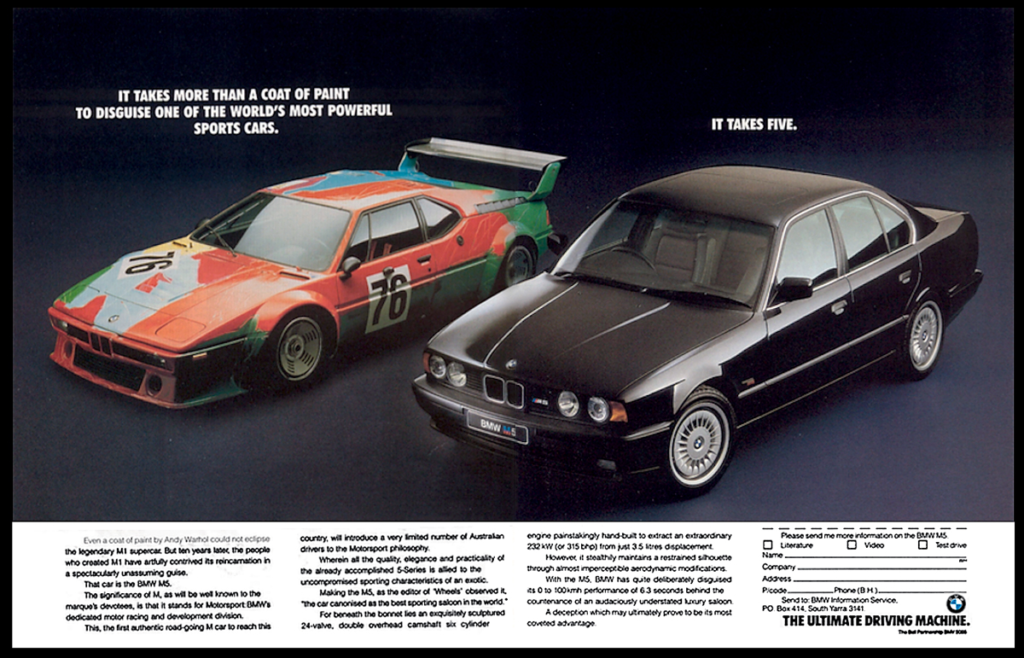
La lignée des moteurs M5 remonte traditionnellement au “six” M88 de la BMW M1, bien que le véritable géniteur soit la BMW 3.0 CSL. La version M88/3 sans carter sec a été attribuée à la M5 E28 en Europe, tandis que le premier moteur étiqueté S38B35 était sa version “catalytique” pour l’Amérique. Les moteurs S38 de la E34 ont hérité d’un bloc en fer et d’une tête à double arbre à cames en tête à 24 soupapes.
BMW a égalé le système d’essuie-glace innovant de Mercedes, qui a nettoyé 86 % de la vitre, en étendant la portée de ses essuie-glaces et en ajoutant un mécanisme à la base pour améliorer l’adhérence du balai à faible vitesse. Ils ont également introduit une fonction unique où le fait de tirer et de maintenir la poignée de la porte active le chauffage de la serrure, un ajout astucieux pour les climats plus froids.
Des appuis-tête arrière rabattables actionnés par des servomoteurs au lieu de ressorts au système d’antipatinage plus sophistiqué qui gère à la fois la perte d’adhérence et la décélération soudaine, BMW semblait déterminé non seulement à rivaliser avec ses concurrents, mais aussi à être à la pointe de l’innovation. Les nouvelles caractéristiques de chaque modèle visaient à surpasser celles de l’autre, BMW affinant continuellement ses conceptions pour répondre aux avancées de Mercedes.
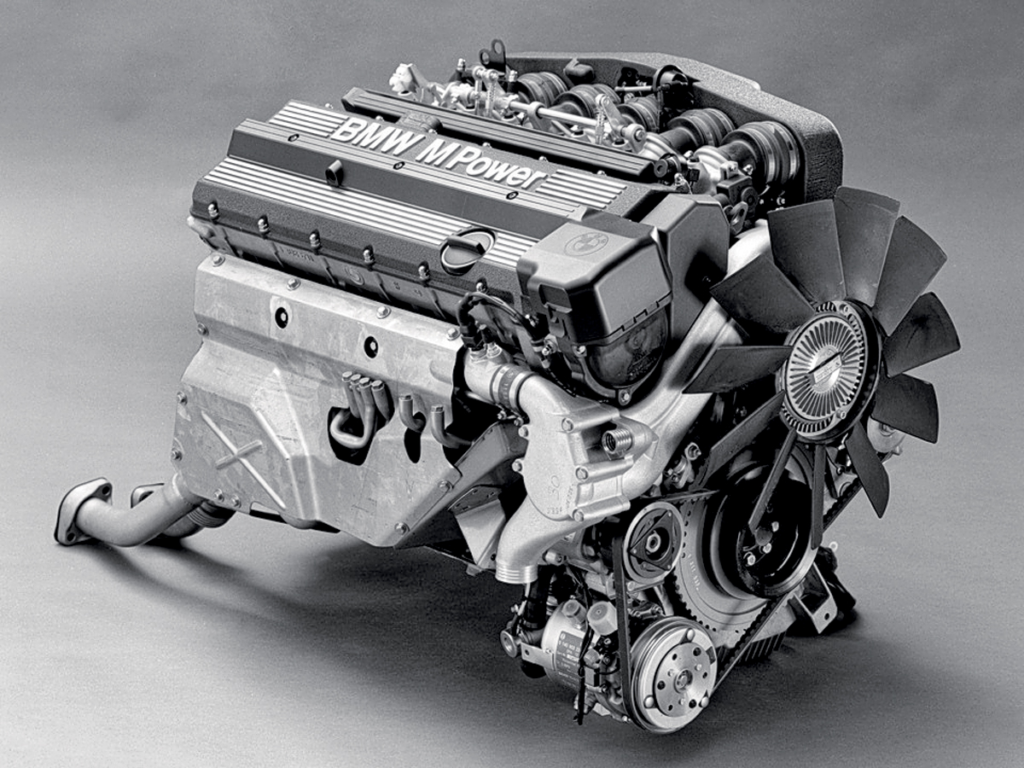
Le moteur S38B36 (315 ch) de la M5 préfacelift avait en fait une cylindrée de 3535 cm3, mais était désigné 3.6 pour le différencier du moteur prédécesseur d’une cylindrée de 3453 cm3 sur la M5 E28.
En outre, le catalogue de BMW justifiait les caractéristiques de tenue de route de la M5, indiquant un réglage délibéré pour un sous-virage neutre à léger qui pouvait passer au survirage à l’accélération – peut-être un clin d’œil à la nature “à la dérive” de la “124”.
Cette rivalité a non seulement repoussé les limites de la technologie automobile, mais a également mis en évidence l’esprit de compétition intense entre les deux marques. Si la E34 a brièvement devancé la W124, elle n’a pas réussi à reproduire l’impact révolutionnaire de la E32 à douze cylindres. Bien qu’elle partage la plate-forme de la “Seven”, la “Five” a toujours été à sa poursuite, adoptant des innovations telles que les carrosseries de break, la transmission intégrale et des dispositifs de sécurité améliorés qui faisaient écho à ceux mis au point par Mercedes. La BMW M5 reste un monument de cette rivalité féroce, démontrant que la concurrence est le moteur de l’innovation et de l’excellence dans l’industrie automobile.
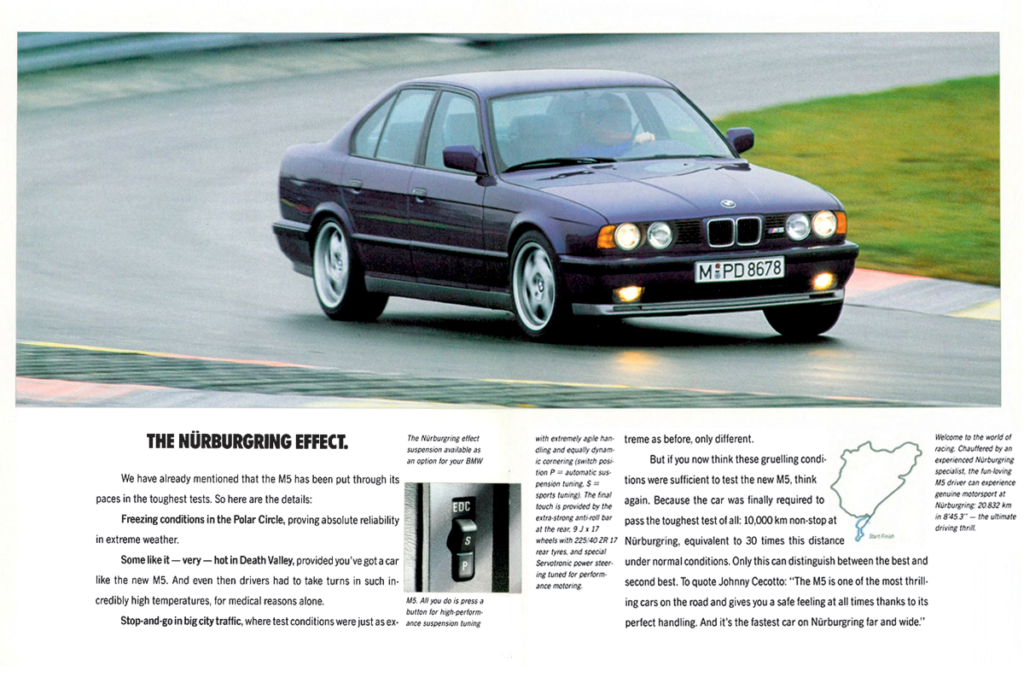
L’effet Nürburgring signifie que lors des essais, la BMW M5 berline équipée d’amortisseurs adaptatifs EDC a parcouru dix mille kilomètres sans interruption sur la “boucle nord” du Nürburgring et a enregistré le meilleur temps de 8’45.3″ (sur un circuit de 20 832 km).
Il y a trois ans, à l’occasion du 30e anniversaire de la Mercedes 500 E, le service de presse de Porsche a publié une interview de Michael Hölscher, chef de projet pour la Typ 2758. Les interventions ultérieures de Hölscher dans les podcasts ont permis de mieux comprendre les nuances de développement de ce modèle emblématique. Il a précisé que l’agencement de la berline, le choix du moteur et de la transmission du roadster 500 SL, ainsi que le design et l’aérodynamique, ont tous été déterminés exclusivement par Mercedes. Porsche était principalement chargé d’intégrer ces composants dans le châssis de la W124, qui n’avait pas été conçu à l’origine pour accueillir des moteurs V8.
Cette collaboration a nécessité d’importantes adaptations, notamment le déplacement des conduits d’admission, le réacheminement des conduites de frein et de carburant, l’ajustement du tunnel central, l’élargissement de la piste et la réalisation d’un programme complet d’essais de conduite. Il est intéressant de noter que Mercedes a choisi de ne pas inclure le réglage du Nürburgring dans ce projet, ce qui souligne un scénario dans lequel les spécifications du client étaient primordiales pour Porsche.
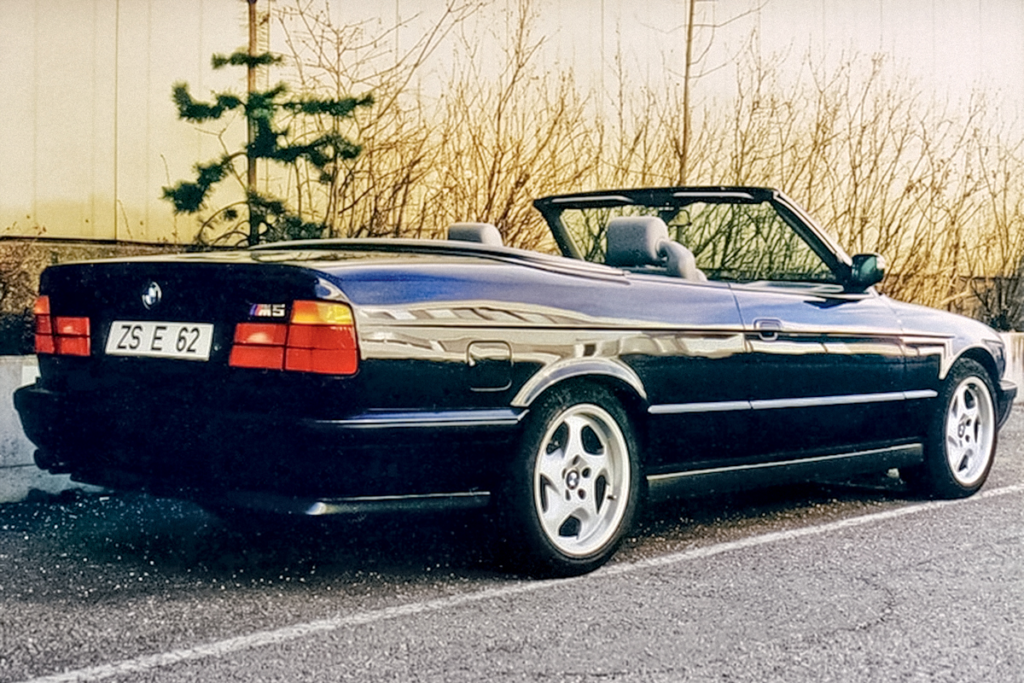
Au salon de l’automobile de Genève de 1989, une M5 décapotable dotée d’une carrosserie E35 devait être présentée, mais une semaine avant la première, BMW a craint que cela ne nuise à la demande pour la M3 ouverte et a annulé le projet. Le prototype n’a été dévoilé qu’en 2009.
Une innovation notable de Zuffenhausen a été le développement du système de gestion électronique du moteur. En effet, la 500 E a été pionnière tant pour Mercedes que pour Porsche, car elle a été le premier véhicule équipé d’un système de bus CAN.
M. Hölscher a également démenti le mythe selon lequel la 500 E ne pouvait pas être installée sur la chaîne de montage de Sindelfingen en raison de ses ailes avant excessivement larges, qui auraient été conçues par Porsche. Il a expliqué que ces ailes avaient en fait été conçues par les designers de Mercedes, qui étaient parfaitement conscients des contraintes de la chaîne de montage. La décision de ne pas adapter l’équipement de l’usine de Sindelfingen pour des ailes plus larges, mais de sous-traiter certaines étapes de la production à Porsche, était une stratégie rentable. Cela soulève une possibilité intrigante : peut-être Mercedes avait-elle l’intention d’assembler cette berline spéciale dans un lieu unique, à l’écart des chaînes de production standard, à l’instar de l’approche adoptée par BMW.
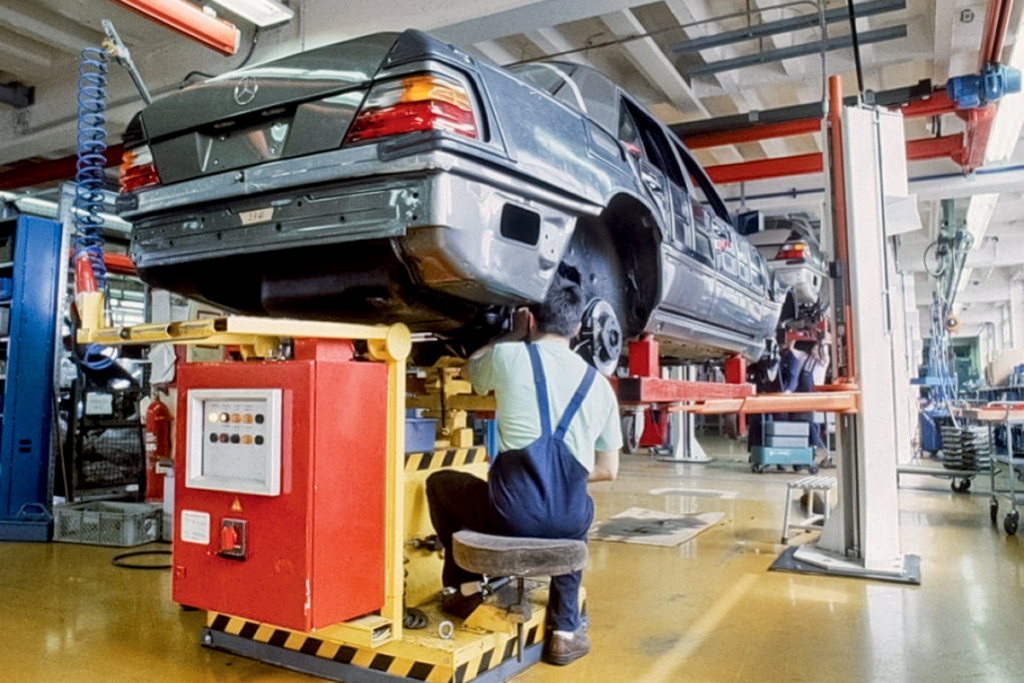
Dans l’usine Porsche, les voitures Mercedes étaient assemblées sans convoyeur, sur des élévateurs et des chariots. Le code VIN de ces voitures devrait inclure les numéros 124.036.
En fin de compte, la Mercedes 500 E a été assemblée sur trois sites. Les panneaux de carrosserie estampillés sont transportés par camion de Sindelfingen à Zuffenhausen, où Porsche ajoute des pièces et les assemble dans des châssis dans le bâtiment Reutter Bau, du nom de l’historique Reutter Karosseriewerk, un atelier de carrosserie qui a travaillé avec Ferdinand Porsche à partir de 1906 et a joué un rôle important dans les premières carrosseries des voitures Porsche. Après l’assemblage initial, les cadres ont été renvoyés à Sindelfinden pour y être peints, puis à Zuffenhausen pour l’assemblage final dans l’usine Rössle Bau, qui abritait auparavant la production de la Porsche 959.
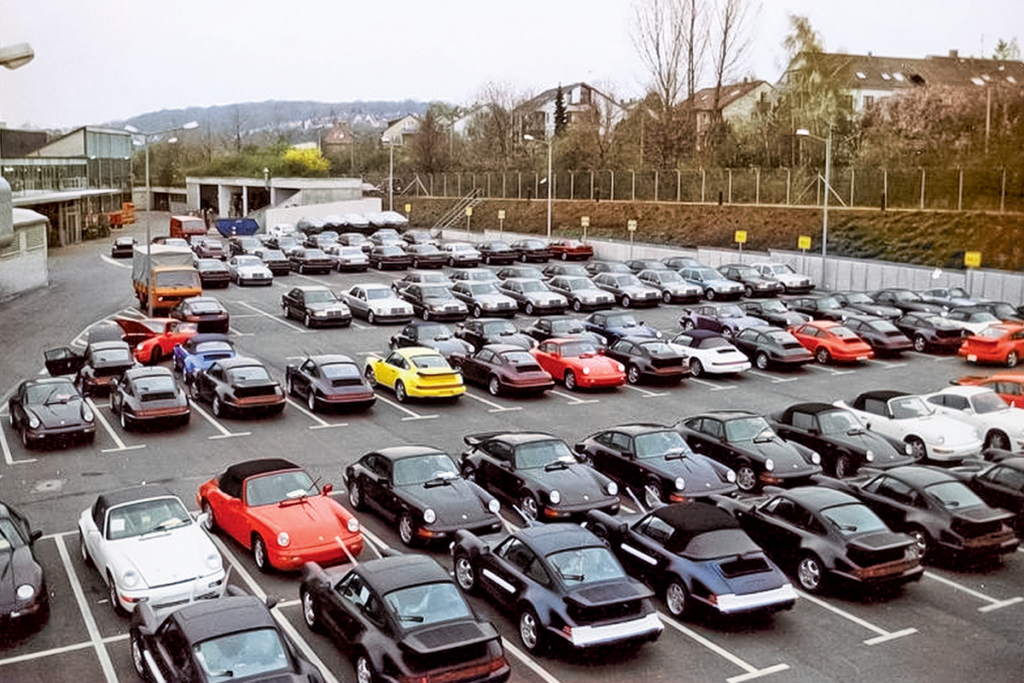
Début des années 90, les produits finis à l’usine de Zuffenhausen : plusieurs Porsche 964 et une quarantaine de Mercedes en arrière-plan.
La complexité logistique de ce processus était considérable : il fallait 18 jours pour fabriquer chaque véhicule. Malgré cela, le processus de production s’est avéré plus efficace que celui de la BMW M5. Mercedes avait initialement prévu que Porsche produise dix voitures par jour, mais en raison de la forte demande, les taux de production ont doublé.
Proposée à un prix supérieur à celui de la classe S, soit 135 000 Deutsche Marks, avec un pic de demande et de production en 1992, la 500 E est rapidement devenue la E 500 dans le cadre du lifting de 1993 qui a transformé l’ensemble de la série “124” en classe E. Bien que l’ingénierie soit restée la même, l’augmentation du prix à 146 000 marks a entraîné une baisse des ventes, qui a abouti à l’arrêt de la production en 1995. Cependant, la 400 E (plus tard E 420), moins puissante, a continué à être vendue jusqu’en 1996 en deux fois plus grand nombre.
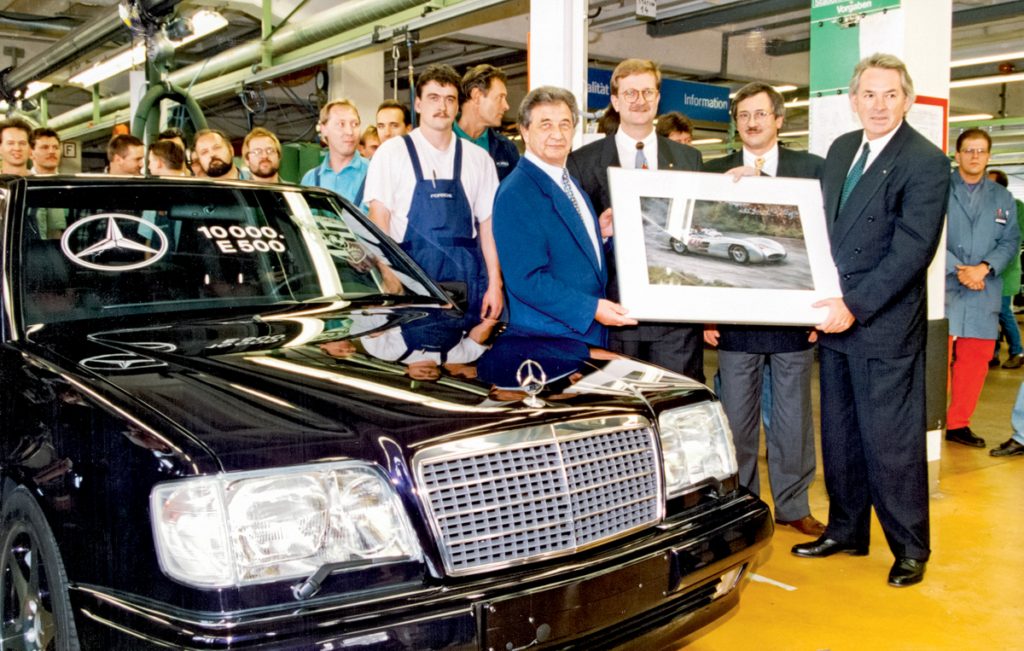
La 10 000e Mercedes “Five-Hundred” a été produite en octobre 1994 – déjà avec l’indice E 500 lifté. Ensuite, 479 autres unités ont été assemblées. La voiture a été offerte à Hans Herrmann, qui a couru pour Mercedes en Formule 1 dans les années 50 et qui, en 1970, a remporté la toute première édition du Mans pour Porsche.
Ce projet a non seulement stabilisé la situation financière de Porsche, mais il a également préparé le terrain pour des projets futurs tels que l’Audi RS2, où Porsche a exercé une plus grande influence en matière d’ingénierie. Le leadership de Michael Hölscher s’est étendu au-delà de ce projet, contribuant au développement de la Carrera GT et de la Porsche 918 Spyder avant son départ à la retraite en 2016.
Mercedes, ayant reconnu la nature lucrative des modèles de performance grâce au projet 500 E, a décidé en 1993 de garder ce “caviar” de l’industrie automobile exclusif, ce qui a conduit à la sortie de la première Mercedes C 36 AMG et a ouvert la voie à de futures innovations de haute performance bien connues aujourd’hui.
Photo : BMW | Mercedes-Benz | Sergey Znaemsky
Il s’agit d’une traduction. Vous pouvez lire l’article original ici : Эхо друг друга : как создавались BMW M5 и Mercedes-Benz 500 E из нашего ретротеста

Publié Juin 20, 2024 • 14m à lire

